|
KWANZAA
Thursday, December 26, 2013 - Wednesday, January 1, 2014.
Guest Writer for This Unit: Willie Dwayne Francois III, Director of the Young Ministers' Corner of The African American Lectionary
The unit you are viewing, Kwanzaa, is a compact unit. This means that it is not a complete commentary of the Scripture(s) selected for this day on the calendar, nor does it have a full, supporting cultural resource unit and worship unit. Instead, to enliven the imagination of preachers and teachers, we have provided a sermonic outline, songs, suggested books, and suggested articles, links, and videos. For additional information, see Kwanzaa in the archives of the Lectionary for 2008–2012.
I. Description of Liturgical Moment
Founded by Maulana Karenga in 1966, Kwanzaa celebrates the Africanity and simultaneously honors the individuality and communality of Black persons in America. Kwanzaa is a seven-day celebration of ethics and values fertile for producing a workable world, self-respect, and productive communities. Known as the Nguzo Saba, the principles of Kwanzaa are:
 |
Umoja (oo-mo-jah)—Unity
To strive for and maintain unity in the family, community, nation, and race. |
 |
Kujichagulia (koo-gee-cha-goo-lee-yah)—Self-Determination
To define ourselves, name ourselves, create for ourselves, and speak for ourselves. |
 |
Ujima (oo-gee-mah)—Collective Work and Responsibility
To build and maintain our community together and make our brother's and sister's problems our problems and to solve them together. |
 |
Ujamaa (oo-jah-mah)—Cooperative Economics
To build and maintain our own stores, shops, and other businesses and to profit from them together. |
 |
Nia (nee-yah)—Purpose
To make our collective vocation the building and developing of our community in order to restore our people to their traditional greatness. |
 |
Kuumba (koo-oom-bah)—Creativity
To do always as much as we can, in the way we can, in order to leave our community more beautiful and beneficial than we inherited it. |
 |
Imani (ee-mah-nee)—Faith
To believe with all our heart in our spiritual heritage, our people, our parents, our teachers, our leaders, and the righteousness and victory of our struggle. |
Kwanzaa is designated as a season of remembering the stories of struggle and moving toward new horizons of human harmony. Kwanzaa is about making room for people, culture, family, and the common good. Kwanzaa's emphasis on the interplay of togetherness and individuality reminds African Americans of the dignity of persons and the potential embedded in deliberate solidarity. The African American Lectionary's Kwanzaa focus for this year is Nia, Purpose.
II. Kwanzaa: Sermonic Outline
A. Sermonic Text(s): 2 Kings 6:1-7
(v. 1) Now the company of prophets said to Elisha, 'As you see, the place where we live under your charge is too small for us. (v. 2) Let us go to the Jordan, and let us collect logs there, one for each of us, and build a place there for us to live.' He answered, 'Do so.' (v. 3) Then one of them said, 'Please come with your servants.' And he answered, 'I will.' (v. 4) So he went with them. When they came to the Jordan, they cut down trees. (v. 5) But as one was felling a log, his axe head fell into the water; he cried out, 'Alas, master! It was borrowed.' (v. 6) Then the man of God said, 'Where did it fall?' When he showed him the place, he cut off a stick, and threw it in there, and made the iron float. (v. 7) He said, 'Pick it up.' So he reached out his hand and took it.
B. Possible Titles
i. Reclaiming Your Cutting Edge
ii. For Us, By Us
iii. All Hands on Deck
iv. What's It Worth to You?
C. Point of Exegetical Inquiry
In this pericope, the guild of prophets under Elisha's tutelage dramatizes a response to growing pains in a conflictual context. The text depicts a college of prophets committed to expanding their living and learning space through personal sacrifice and collaborative engagement in times of national turmoil. To secure and advance the purpose of the guild, they proposed to work together to build something for themselves, something to include and accommodate the explosive growth. This building project is situated in the context of famine and war, which explains the frantic response of the prophet who lost the borrowed axe. Also, notice that this miracle convenes at the same site as the healing of Naaman—in the Jordan River.
III. Introduction
The power of Kwanzaa is that it offers reflective observers dedicated time in the year to reflect on the potential of humanity and the trans-immanence of togetherness. Carving out this time for reflective celebration thrusts us into the heart of a lived Sankofa—a going back and reclaiming of knowledge from the past to forge a way forward through the transformative wisdom of our people.
This week is a time to go back in order to go forward. A year should not pass without our risking a journey into the memory of freedom fighters from Nat Turner to Fannie Lou Hamer. This is a week to see the fresh possibilities of unity, self-determination, collective work and responsibility, cooperative economics, purpose, creativity, and faith through the prism of our past.
One such luminary of our layered story in this country is Araminta Ross, better known as Harriett Tubman. The most-noted conductor of the Underground Railroad, Tubman, a former slave, lived a brilliant career of journeying back into the South to free those on the underside of the chattel system. In a ten-year block, she risked 19 trips and escorted over 300 Africans to the North, the strange land of freedom. She has been recorded to say, "If I could have convinced more slaves that they were slaves, I could have freed thousands more." She threw off the labels placed on her and pioneered new pathways for others to do the same in spite of the Fugitive Slave Act of 1850. In establishing her purpose in life, she threw off the identity created by the slave system and self-defined herself as an agent of freedom. She risked death, imprisonment, and rape to expose others to the blessings and burdens of freedom. She risked everything for freedom and the freedom of others. However, she never bought into the hype of her productivity. Her purpose in the project of emancipation required the hospitality of wives, the bravery of Frances Harper, assistance of abolitionists, and a cadre of the nameless. This daring woman of distinction proves that one's purpose should never be privatized.
Similarly, we find ourselves in a text that dramatizes the achievement of one's purpose through personal responsibility and collaboration.
IV. Moves/Points
Move/Point One – Embrace compulsory inconveniences.
a. In Pursuit of Instruction: Though the prophets could have returned to their homes, they decided to stay in the cramped house of the prophets to prepare and advance their possibilities as prophets. They sacrificed their comfort in the name of preparation with and the mentorship of Elisha.
b. In Pursuit of Inclusivity: In order to create room for everyone, they proposed to build an edifice themselves, which suspended their formal education with Elisha.
c. In Pursuit of (Ancestral) Integrity: They proposed to build this house of learning and fellowship near the Jordan River—a river etched in the cultural and national memory of the Israelites. This river carried profound connections to their ancestral narrative; a river with signal importance for their journey to the Promised Land.
Move/Point Two – Encourage collaborative investment.
a. Collaboration In Requirements: The growth of this prophetic ministry required collective responsibility in erecting the new accommodations. Each prophet is tasked with felling and delivering one log. Every prophet was needed to erect this building. This building project honors the individual as a critical part of community by recognizing each prophet's responsibility in leveling and gathering lumber for the edifice.
b. Collaboration In Resources: As one prophet is felling lumber for the building, his ax head is dislodged from its handle and sinks into the river. We learn that the axe is borrowed. The reference to the borrowed ax suggests someone loaned it to the project. Note that iron axes were expensive tools.
Move/Point Three – Exceed our inhibitions.
a. We Will have Unforeseen Setbacks: While he was working, the prophet's instrument unexpectedly broke. Without the axe head, the student was inhibited from working. According to the requirements, every prophet had to contribute to complete this building project. This setback affected the entire group.
b. We Need Useful Strategies: In response to the unexpected setback, the young prophet capitalizes on proactive planning. Before they set out for the project, one of the students asked Elisha to join them, the one capable of performing miracles and mitigating their concerns. This unfortunate prophet benefits from the plan to have the accompaniment of the distinguished Man of God.
c. We Experience an Unprecedented Salvaging: Through the quiet miracle of Elisha, his student recovers what he lost. After Elisha causes the axe head to float in the Jordan, he instructs his pupil to retrieve the axe head. The student is enabled to return to work and contribute to the work of God. Likewise, he is freed from the immense debt of a broken or lost iron axe.
V. Celebration
In response to the loss and misfortune that impaired the progress of the prophets, the man of God demonstrates that our cutting edge is never beyond recovery. Elisha's activity is actually characteristic of the ways God works in our moments of challenge. When life and/or your assignment result in moments of regression, retardation, stymie, setback, diversions, and detours, recovery is possible. Why? Because our God has a restorative career. When you believe God is able, you gain confidence to do and be what you have never done and been. Trust in God breeds stability, rejects low self-esteem, claims peace, turns you into a living advertisement of achievement, affirms personhood, consecrates your potential, overcomes the fears of life, imagines a way of togetherness with your family and your people, and instills new possibilities of loving, living, learning, lifting, and leading.
VI. Illustration
A Team Touchdown
The other day I was watching a football game and I noticed that the quarterback was about to run the ball until he noticed several guys from the other team running towards him. Because he noticed the pressure that was coming his way, he looked around for a moment, and when he found the right person he threw the ball to him. That man then went on to score a touchdown for the team. As I reflected on that interaction, I realized ministry and those who do ministry should function that way. So often, many of us have possession of a ministry and we think it's our job to run every play. Unfortunately, people who hog the ball and never pass it often get tackled before making any progress. But if we do like that quarterback and realize that God has other people on the team who are just as capable of running the ball, then our ministry teams will gain more victories. Individuals do not score touchdowns; they're scored when everyone on the team works together. Somebody ought to look at your neighbor and say, "Neighbor, pass the ball."
| |
—Tamika Bell, Birmingham, Alabama |
This illustration is taken from the Sermon Illustration section of the African American Lectionary. Please see this section for additional illustrations.
VII. Descriptive Details in This Passage
| Sights: |
A cramped house; prophets traveling to chop woods; trees falling to the ground; axe head flying off its handle, sinking to the bottom of the Jordan River, and floating to the surface; Elisha throwing a stick into the river; a student-prophet reaching for the floating axe head;
|
| Sounds: |
Chopping wood; trees hitting the ground; the frantic voice of a pupil; and
|
| Colors: |
The brownish, murky Jordan River; the beige garments of the prophets; and the brown dusty feet of the prophets from working on the construction project site. |
VIII. Songs to Accompany This Sermon
A. Well-known Song(s)
- Imani. By Phillip Manuel and Bill Summers
- I Need You to Survive. By David Frazier
- Happy Kwanzaa. By Reggie Calloway
B. Modern Song(s) (Written between 2000–2011)
- Don't Forget to Remember. By Donald Lawrence
- Faithful Is Our God. By Jules Bartholomew
- How Great Is Our God. By Jesse Reeves and Chris Tomlin
C. Spiritual(s) and Hymn(s)
- Blest Be the Tie That Binds. By John Fawcett. Tune by John G. Nageli. Arr. by Lowell Mason
- There's No Me, There's No You. By Evelyn Reynolds. Arr. by Nolan Williams, Jr.
- How Great Thou Art. By Stuart K. Hine
D. Liturgical Dance Music
- Kumbaya. African American Spiritual. Adapted lyrics and music by Kurt Carr
- Brighter Day. By Kirk Franklin
- Something Inside So Strong. By Labi Siffre
E. Song(s) for the Period of Prayer
- My Faith Looks Up to Thee. By Ray Palmer. Tune, (OLIVET), by Lowell Mason
- Be Blessed. By Paul Morton
F. Sermonic Selection(s)
- Seven Principles. By Bernice Johnson Reagon
- Day by Day. By Caroline Sandell-Berg. Tune, (BLOTT EN DAG), by Oscar Ahnfelt
- I'll Trust You. By Richard Smallwood
G. Invitational Song(s)
- I Will Trust in the Lord. Traditional Spiritual
- I'm Available to You. By Carlis Moody, Jr.
IX. Videos, Audio, and/or Interactive Media
X. Books to Assist in Preparing Sermons, Bible Studies, and/or Worship Services Related to Kwanzaa
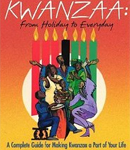 |
Angaza, Mantefa. Kwanzaa: From Holiday to Everyday. New York, NY: Dafina, 2007. |
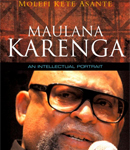 |
Asante, Molefi Kete. Maulana Karenga: An Intellectual Portrait. Stafford BC: Polity, 2009. |
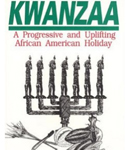 |
Madhubuti, Haki R. Kwanzaa: A Progressive and Uplifting African American Holiday. Chicago: Third World Press, 1972. |
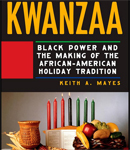 |
Mayes, Keith A. Kwanzaa: Black Power and the Making of the African-American Holiday Tradition. New York: Routlege, 2009. |
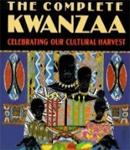 |
Riley, Dorothy Winbush. The Complete Kwanzaa: Celebrating Our Cultural Harvest. New York: HarperCollins, 1995. |
XI. Links to Helpful Websites
XII. Disability Awareness Information
The African American Lectionary wants all churches to do a better job of including the disabled/differently abled. Please consider the following when planning all worship services and activities, including Kwanzaa, and all other church activities:
We need to give people with disabilities access to society's most important place: our compassionate hearts. In fact, if we each begin with opening our hearts, access to our church buildings, programs, and our lives will be a natural expression of welcoming all God's children into the community of Christ's body, freely and without prejudice. Our proactive inclusion of adults and children with disabilities into the full life of our churches then will become the living and best example of being like Christ. (Taken from The Episcopal Disability Network. Online location: http://www.disability99.org/id69.html accessed 19 June 2013.)
XIII. Notes for Select Songs
A. Well-known Song(s)
- Imani. By Phillip Manuel and Bill Summers
Location:
Summers, Bill. The Essence of Kwanzaa. New Orleans, LA: Monkey Hill Records, 1997.
- I Need You to Survive. By David Frazier
Location:
Walker, Hezekiah. The Essential Hezekiah Walker. New York, NY: Verity, 2007.
- Happy Kwanzaa. By Reggie Calloway
Location:
Pendergrass, Teddy. This Christmas I'd Rather Have Love. New York, NY: Wind Up Records, 1998.
B. Modern Song(s) (Written between 2000–2011)
- Don't Forget to Remember. By Donald Lawrence
Location:
Lawrence, Donald and the Tri City Singers. Bible Stories. New York, NY: Zomba, 2004.
- Faithful Is Our God. By Jules Bartholomew
Location:
Hezekiah Walker and the Love Fellowship Crusade. 20/85 Experiences. New
York, NY: Verity, 2005.
- How Great Is Our God. By Jesse Reeves and Chris Tomlin
Location:
Nelson, Jonathan & Purpose. Right Now Praise. New York, NY: Integrity, 2008.
C. Spiritual(s) and Hymn(s)
- Blest Be the Tie That Binds. By John Fawcett. Tune by John G. Nageli. Arr. by Lowell Mason
Location:
African American Heritage Hymnal. Chicago, IL: GIA Publications, 2001. #341
- There's No Me, There's No You. By Evelyn Reynolds. Arr. by Nolan Williams, Jr.
Location:
Zion Still Sings for Every Generation. Nashville, TN: Abingdon Press, 2007. #92
- How Great Thou Art. By Stuart K. Hine
Location:
African American Heritage Hymnal. #148
D. Liturgical Dance Music
- Kumbaya. African American Spiritual. Adapted lyrics and music by Kurt Carr
Location:
Carr, Kurt. No One Else. New York, NY: Zomba, 2001.
- Brighter Day. By Kirk Franklin
Location:
The Rebirth of Kirk Franklin. Inglewood, CA: Gospocentric, 2002.
- Something Inside So Strong. By Labi Siffre
Location:
Armstrong, Vanessa Bell. Gospel Greats Live, Vol. 1. New York, NY: BMG Special Product, 2004.
E. Song(s) for the Period of Prayer
- My Faith Looks Up to Thee. By Ray Palmer. Tune, (OLILVET), by Lowell Mason
Location:
African American Heritage Hymnal. #456
- Be Blessed. By Paul Morton
Location:
Still Standing. Nashville, TN: Light Records, 2006.
F. Sermonic Selection(s)
- Seven Principles. By Bernice Johnson Reagon
Location:
Women of the Calabash. The Kwanzaa Album. New York, NY: Orchard, 1998.
- Day by Day. By Caroline Sandell-Berg. Tune, (BLOTT EN DAG), by Oscar Ahnfelt
Location:
Church of God in Christ. Yes, Lord! Church of God in Christ Hymnal. Memphis, TN:
Church of God in Christ Pub. Board in association with the Benson Co., 1982. #90
- I'll Trust You. By Richard Smallwood
Location:
Smallwood, Richard with Vision. Journeys: Live in New York. New York, NY:
Verity Records, 2006.
G. Invitational Song(s)
- I Will Trust in the Lord. Traditional Spiritual
Location:
Boyer, Horace Clarence. Lift Every Voice and Sing II: An African American Hymnal. New York, NY: Church Pub., 1993. #192
Cleveland, J. Jefferson, and Verolga Nix. Songs of Zion. Nashville, TN: Abingdon, 1981. #14
- I'm Available to You. By Carlis Moody, Jr.
Location:
Brunson, Milton. Available to You. New York, NY: Word, 1988.
|